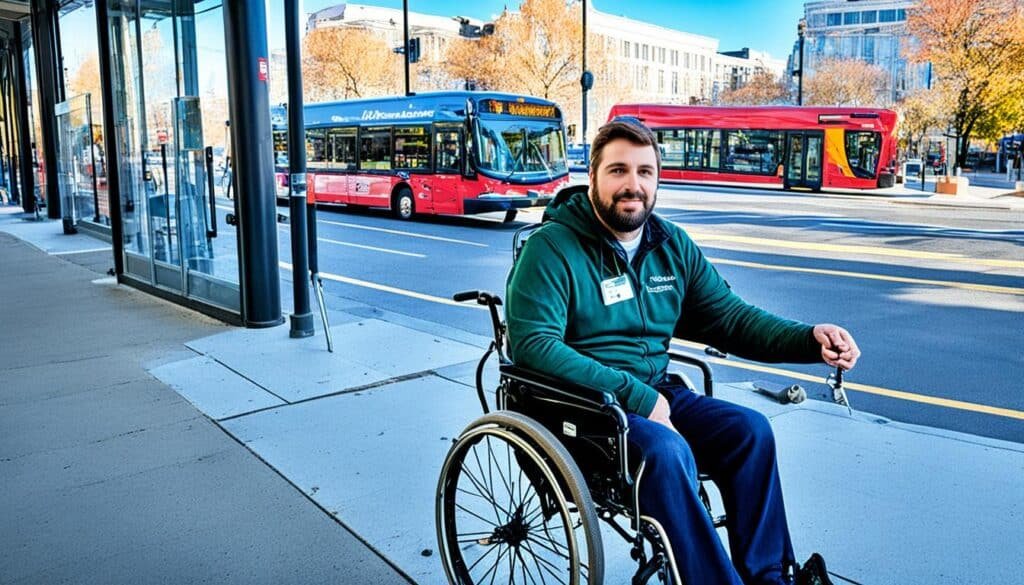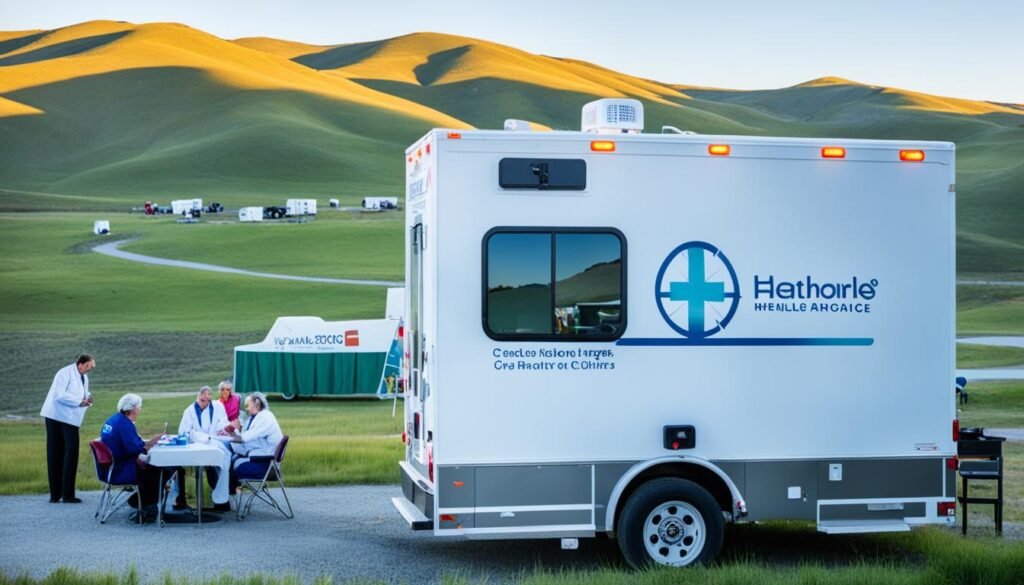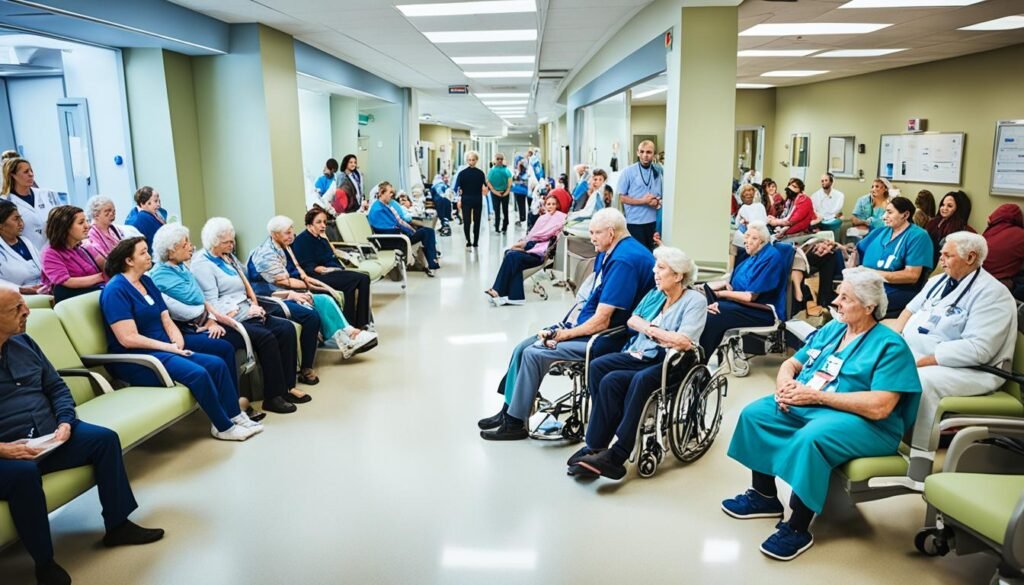Medical solutions play a crucial role in improving healthcare accessibility and enhancing patient care. In the United States, many individuals face barriers to accessing essential healthcare services. High healthcare costs, transportation limitations, and implicit bias are some of the problems that hinder access to healthcare. Expanding insurance coverage, implementing telehealth services, investing in mobile clinics, educating the public about different healthcare sites, and promoting cultural responsiveness are potential solutions to improve accessibility to healthcare.
Key Takeaways:
- Medical solutions are vital for improving healthcare accessibility and patient care.
- Barriers like high healthcare costs, transportation limitations, and implicit bias hinder access to healthcare.
- Expanding insurance coverage, implementing telehealth services, and investing in mobile clinics can enhance accessibility.
- Educating the public about different healthcare sites and promoting cultural responsiveness are also crucial for improving accessibility.
- Addressing these challenges can ensure equal access to healthcare and improve patient outcomes.
High Health Care Costs
High healthcare costs pose a significant challenge to accessing quality healthcare in the United States. Many Americans, even those with insurance, struggle to afford the out-of-pocket expenses associated with medical care. These exorbitant costs create financial burdens that impact individuals and families, leading to health disparities and decreased healthcare accessibility.
According to a study, approximately 30% of Americans consider high healthcare costs as a barrier to receiving necessary treatment. Out-of-pocket costs, including deductibles, copayments, and coinsurance, can quickly add up, deterring individuals from seeking the care they need. This financial burden is a barrier especially for those with chronic illnesses or low-income individuals.
The United States has the highest income-based health disparities among developed nations, with 38% of adults skipping necessary healthcare services due to financial limitations. This disparity disproportionately affects marginalized communities, perpetuating longstanding health inequalities.
Rising medical costs, coupled with the prevalence of high-deductible insurance plans, further exacerbate the challenge of accessing healthcare. High-deductible plans require individuals to pay a significant amount of money out-of-pocket before insurance coverage kicks in, making it difficult for many to afford necessary care.
The Impact of High Health Care Costs
The financial burden of high healthcare costs has wide-ranging consequences:
- Delayed or Deferred Care: Individuals may postpone or avoid seeking medical attention, leading to delayed diagnoses, worsening conditions, and more extensive treatment requirements.
- Health Disparities: The inability to afford healthcare disproportionately affects low-income individuals and communities of color, widening existing health disparities.
- Increased Debt: Accumulating medical bills can lead to substantial debt, hindering individuals’ financial stability and overall well-being.
- Reduced Preventive Care: The cost barrier discourages individuals from accessing preventive care, which is vital in detecting and addressing potential health issues before they escalate.
To address high healthcare costs and improve accessibility, comprehensive reform and innovative solutions are necessary. Policies focused on reducing out-of-pocket expenses, enhancing price transparency, and promoting competition among healthcare providers can help alleviate the financial burden on individuals. Additionally, initiatives aimed at addressing underlying factors contributing to high healthcare costs, such as prescription drug pricing reforms and improved efficiency in healthcare delivery, are critical.
International Comparison of Health Care Costs
| Country | Healthcare Expenditure per Capita (USD) | Out-of-Pocket Payments (% of Total Health Expenditure) |
|---|---|---|
| United States | $10,966 | 11.3% |
| Switzerland | $7,001 | 29.8% |
| Australia | $5,331 | 16.9% |
| United Kingdom | $4,019 | 8.4% |
| Canada | $4,052 | 13.3% |
Note: Data represents healthcare expenditure per capita and out-of-pocket payments as a percentage of total health expenditure.
Addressing high healthcare costs is crucial for ensuring equitable access to healthcare and improving population health outcomes. By implementing policies and initiatives that reduce financial barriers, promote affordability, and enhance price transparency, the healthcare system can become more inclusive and accessible to all individuals, regardless of their socioeconomic status.
Transportation Barriers

Access to healthcare is significantly impacted by transportation barriers, especially in rural areas. People residing in remote regions face challenges in traveling long distances to receive essential medical care. Limited access to public transportation and insufficient internet services further exacerbate these transportation limitations. This lack of transportation options affects not only rural areas but also patients living in suburban and urban locations, imposing hurdles to accessing healthcare facilities.
For individuals in rural areas, transportation barriers can be particularly daunting. The distance from medical facilities and the lack of public transportation options make it difficult for them to reach healthcare providers. Many rural communities struggle with inadequate infrastructure, making it challenging to establish reliable transportation systems. This limited access to transportation prevents individuals, including those with chronic illnesses, from receiving regular care, leading to decreased healthcare accessibility.
In addition to rural areas, patients in suburban and urban regions also encounter obstacles due to transportation limitations. *Lack of public transportation* can make it challenging for individuals to commute to healthcare facilities, especially if they are dependent on public transit systems. The absence of accessible and affordable transportation options can result in delayed or missed appointments, hindering timely access to necessary medical care.
Transportation barriers significantly impact access to healthcare, particularly in rural areas. Limited access to public transportation and inadequate infrastructure exacerbate the challenges faced by individuals in reaching healthcare providers. These barriers prevent many patients, including those with chronic illnesses, from receiving regular care, resulting in decreased healthcare accessibility.
The consequences of transportation barriers go beyond the inconvenience of travel. They have a direct impact on healthcare outcomes, as delayed or missed appointments can lead to untreated conditions, worsened health conditions, and increased healthcare costs. Finding appropriate solutions to address transportation barriers is critical to improving healthcare access for all individuals, regardless of their geographic location.
Efforts to mitigate transportation barriers include improving public transportation services, establishing transportation reimbursement programs, and implementing innovative solutions such as telehealth services and mobile clinics. By investing in strategies that address transportation limitations, communities can ensure that individuals have the means to access the healthcare they need, ultimately improving healthcare accessibility and outcomes.
The Importance of Public Transportation in Addressing Transportation Barriers
Public transportation plays a vital role in mitigating transportation barriers, particularly in areas with limited access to private vehicles. Enhancing existing public transportation systems and expanding coverage can provide individuals with a reliable and affordable means of reaching healthcare providers. Accessible bus routes, shuttle services, and ride-sharing programs can help bridge the gap between patients and medical facilities.
Telehealth Services as a Solution
Telehealth services offer a promising solution to transportation barriers, especially in areas where accessing healthcare facilities is challenging. Through telehealth, patients can receive medical consultations and advice remotely, reducing the need to travel long distances. This option is particularly beneficial for routine check-ups and follow-up visits, minimizing the need for physical transportation while ensuring individuals can still receive the necessary care.
Implicit Bias and Health Care Avoidance

Implicit bias and the fear of experiencing discrimination in healthcare settings have a significant impact on health disparities among communities of color. People belonging to racial and ethnic minorities in the United States often face poorer health outcomes compared to their white counterparts. These disparities manifest in higher infant mortality rates, increased rates of diabetes, and a disproportionate burden of diseases like COVID-19.
Racially biased interactions with healthcare professionals undermine trust and contribute to health care avoidance. When individuals anticipate biased treatment, they are less likely to seek medical services, resulting in delayed or inadequate care. This avoidance further exacerbates existing health disparities and perpetuates inequities in healthcare access.
To address these issues, it is crucial to improve cultural competency among healthcare providers and address the effects of implicit bias. Healthcare professionals must be equipped with the knowledge and understanding of diverse cultures, languages, and socio-economic backgrounds to provide equitable care for all patients.
“Addressing implicit bias in healthcare is essential to reduce health disparities and ensure access to quality care for marginalized communities.”
Promoting Cultural Competency
Enhancing cultural competency within healthcare settings involves ongoing education and training for healthcare providers. This includes gaining awareness of one’s own biases and understanding how they can influence medical decision-making.
- Implementing diversity and inclusion training programs that enable providers to recognize and challenge their implicit biases.
- Incorporating cultural competency modules into medical school curricula to foster cultural sensitivity from the early stages of medical education.
- Encouraging diverse representation in healthcare leadership and professional organizations to ensure a more inclusive and patient-centered approach.
Improving Health Care Access
By addressing implicit bias and improving cultural competency, healthcare providers can help reduce health care avoidance and increase access to care for marginalized communities. This can be achieved through:
- Establishing protocols and guidelines that promote patient-centered care and address the unique needs and concerns of diverse populations.
- Implementing community outreach programs that build trust and engage with marginalized communities to improve health education and awareness.
- Supporting initiatives to diversify the healthcare workforce, ensuring that medical professionals reflect the communities they serve.
Expand Insurance to Cover Health Care Costs

Expanding insurance coverage is a critical step in improving healthcare access and making it more affordable for individuals across the United States. In 2020, approximately 31.6 million people in the country were uninsured, limiting their ability to receive necessary medical services. Through initiatives such as Medicaid expansion, efforts have been made to increase healthcare accessibility for uninsured individuals.
Medicaid expansion has proven to be instrumental in providing insurance coverage for many individuals who were previously uninsured. By expanding Medicaid eligibility criteria, more low-income individuals and families can now access affordable healthcare options. This expansion has resulted in higher insurance rates, both private and public coverage, for adults living in expansion states.
“The expansion of Medicaid has been a game-changer for many uninsured individuals who previously struggled to afford healthcare,” said Dr. Sarah Thompson, a healthcare policy expert. “Medicaid expansion has not only improved access to care but has also provided essential financial protection for those who would otherwise face substantial medical bills.”
Through the expansion of insurance coverage, uninsured individuals have the opportunity to gain access to a range of essential healthcare services, including preventive care, prescription medications, and hospitalization. By mitigating the financial burden associated with healthcare costs, these initiatives enable individuals to seek timely medical attention without the fear of incurring significant expenses.
Benefits of Expanding Insurance Coverage:
- Increased healthcare accessibility for uninsured individuals
- Lower financial burden for medical expenses
- Expanded coverage for preventive care and treatment
- Improved healthcare outcomes through timely interventions
Efforts to expand insurance coverage should prioritize providing free or low-cost health coverage options to uninsured individuals, ensuring that everyone has access to essential healthcare services. By expanding insurance coverage, we can take a significant step towards achieving a more equitable healthcare system that prioritizes the well-being of all individuals.
| State | Medicaid Expansion Status | Uninsured Rate (2020) |
|---|---|---|
| Texas | Not Expanded | 17.7% |
| California | Expanded | 7.7% |
| Florida | Not Expanded | 13.2% |
| New York | Expanded | 5.0% |
Extend Telehealth Services

Telehealth services are revolutionizing healthcare accessibility by offering remote access to healthcare providers, especially in areas with limited healthcare infrastructure. This advancement in technology is particularly beneficial for small rural communities that may lack large hospitals and specialized care.
With telehealth consultations, patients in rural areas have the opportunity to connect with healthcare professionals without the need to travel long distances. This remote access enables doctors to coordinate care and provide necessary medical attention to patients across wide geographical areas.
One key feature of telehealth is videoconferencing, which allows doctors and patients to have face-to-face interactions without being physically present in the same location. This connection, coupled with the use of cloud-based data, ensures comprehensive and efficient care delivery.
Telehealth services offer a more affordable option, especially for routine check-ups. By eliminating the need for travel and reducing associated expenses, telehealth helps make healthcare more accessible and cost-effective.
Expanding telehealth services has the potential to bridge the gap in healthcare access and affordability, particularly in underserved areas. It empowers individuals to seek timely medical care from the comfort and convenience of their own homes, improving overall health outcomes for remote communities.
Image:
Invest in Mobile Clinics

Investing in mobile clinics is an effective strategy to address transportation barriers and improve access to healthcare, particularly in rural areas where access to traditional healthcare facilities can be limited. Mobile clinics are alternative treatment sites that bring medical services directly to communities, making healthcare more accessible for those who might face challenges in reaching conventional healthcare settings.
During the COVID-19 pandemic, mobile clinics played a crucial role in providing testing and treatment resources to underserved communities, ensuring that individuals had access to necessary healthcare services. These clinics have proven instrumental in reaching remote areas and delivering essential care to individuals who might otherwise go without it.
“Mobile clinics bring healthcare services closer to communities, particularly in rural areas with limited access to healthcare facilities.”
Additionally, free-standing emergency departments offer vital emergency care to areas without nearby hospitals. This alternative treatment site ensures that individuals in remote and underserved regions have access to emergency services when they need them most. By investing in these mobile clinics and alternative treatment sites, healthcare access can be significantly improved, especially in rural areas.
Benefits of Mobile Clinics and Alternative Treatment Sites
The use of mobile clinics and alternative treatment sites offers several benefits:
- Increased access to healthcare services for individuals living in rural areas
- Reduced barriers to transportation, making it easier for individuals to receive care
- Improved reach to underserved communities
- Enhanced emergency care options for areas without nearby hospitals
These benefits contribute to improving healthcare accessibility and ensuring that individuals, regardless of their geographic location, can access the care they need.
The Role of Mobile Clinics in Rural Healthcare
Rural areas often face unique challenges when it comes to healthcare accessibility. The lack of healthcare facilities and limited public transportation options make it difficult for individuals to access necessary medical services. Mobile clinics bridge this gap by bringing healthcare services directly to these communities.
Mobile clinics offer a variety of healthcare services, including preventive care, screenings, primary care, and specialty consultations. These clinics are equipped with the necessary medical equipment and staffed by healthcare professionals who provide high-quality care to individuals living in rural areas.
“Mobile clinics bridge the gap between rural communities and essential healthcare services, helping individuals access medical care conveniently.”
By investing in mobile clinics, healthcare organizations demonstrate their commitment to improving healthcare access for all populations, regardless of their location. These clinics play a vital role in improving health outcomes and overall well-being in rural communities, ensuring that no one is left behind when it comes to essential healthcare services.
Educate the Public About Multiple Health Care Sites

Educating the public about different healthcare sites and their services is essential to optimize healthcare access. Many people visit emergency departments unnecessarily due to a lack of awareness about alternative care facilities. Providing information about primary care facilities, urgent care centers, and emergency rooms can guide individuals in seeking the most appropriate care based on their symptoms. Public education initiatives help people make informed decisions about where to seek healthcare, reducing unnecessary emergency visits and promoting efficient use of healthcare resources.
“It is crucial to educate the public about the range of healthcare sites available to them. By understanding the differences in primary care, urgent care, and emergency care, individuals can choose the most suitable option, ensuring they receive timely and appropriate medical attention. This knowledge empowers patients to make informed decisions, optimizing healthcare access and utilization.”
Primary care facilities serve as the initial point of contact for individuals seeking routine medical care. Here, patients can receive preventive services, manage chronic conditions, and access general healthcare services. Primary care providers play a vital role in promoting overall health and well-being by offering comprehensive care and referring patients to appropriate specialists when needed.
Urgent care centers bridge the gap between primary care facilities and emergency rooms. They provide prompt medical attention for non-life-threatening conditions, such as minor injuries or common illnesses. Urgent care centers offer extended hours, including evenings and weekends, ensuring individuals can access healthcare outside traditional office hours.
Emergency rooms are designed to handle critical and life-threatening conditions requiring immediate attention. They provide 24/7 care for severe injuries, chest pain, stroke symptoms, and other medical emergencies.
Benefits of Healthcare Education and Public Awareness:
- Reduces unnecessary visits to emergency departments, leading to more efficient use of healthcare resources.
- Enhances patient outcomes by ensuring timely access to appropriate care.
- Improves healthcare system efficiency by reducing overcrowding in emergency rooms.
- Empowers individuals to take control of their healthcare by making informed decisions.
By promoting healthcare education, encouraging public awareness, and providing clear information about different healthcare sites, we can optimize healthcare access and improve overall patient care. Together, we can build a more efficient and effective healthcare system that meets the needs of all individuals.
Also Read: Breakthroughs in Medical Science: Exploring New Frontiers
Conclusion
Improving healthcare accessibility is crucial for enhancing patient care and promoting overall well-being. By implementing various medical solutions, such as expanding insurance coverage, investing in telehealth services, and establishing mobile clinics, individuals can overcome barriers to accessing healthcare. Additionally, educating the public about different healthcare sites and promoting cultural responsiveness are essential steps towards ensuring equal access to quality care.
Addressing high healthcare costs is vital in improving healthcare accessibility. When individuals face financial burdens, they may delay or avoid seeking necessary medical treatment, leading to adverse health outcomes. By expanding insurance coverage and implementing affordable healthcare options, individuals can receive the care they need without compromising their financial well-being.
Transportation barriers also hinder healthcare access, particularly in rural areas with limited public transportation. Investing in mobile clinics and deploying telehealth services enable individuals to receive medical care closer to their communities, eliminating the need for long-distance travel. Additionally, raising awareness about different healthcare sites helps individuals make informed decisions about where to seek care, improving efficiency and reducing unnecessary emergency visits.
Reducing implicit bias and promoting cultural competency in healthcare settings is essential for eliminating health disparities. By addressing implicit bias, healthcare professionals can build trust and establish positive relationships with patients from diverse backgrounds. Improving cultural responsiveness contributes to better healthcare outcomes and increased patient satisfaction.
FAQs
Q: How can medical solutions improve healthcare accessibility?
A: Medical solutions can improve healthcare accessibility by providing remote services, placing nurses and healthcare professionals in underserved areas, and utilizing technology to connect patients with healthcare providers.
Q: What role do travel nurses play in improving healthcare accessibility?
A: Travel nurses play a crucial role in improving healthcare accessibility by filling staffing gaps in different locations, especially in rural or underserved areas where there is a shortage of healthcare professionals.
Q: How does working with a professional healthcare staffing agency benefit healthcare facilities?
A: Working with a professional healthcare staffing agency provides healthcare facilities with access to a pool of qualified and experienced nurses, streamlines the hiring process, and ensures adequate staffing levels to maintain quality patient care.
Q: What factors should healthcare professionals consider when choosing a company to work with?
A: Healthcare professionals should consider factors such as job opportunities, travel nurse support, company reputation, pay rates, benefits, and the types of assignments offered when choosing a company to work with.
Q: How can nurses and healthcare professionals ensure their safety while on the job?
A: Nurses and healthcare professionals can ensure their safety by following standard safety protocols, communicating effectively with their team, and staying informed about best practices for infection control and workplace safety.
Q: What is the role of a recruiter in the healthcare staffing industry?
A: Recruiters in the healthcare staffing industry connect healthcare professionals with job opportunities, assess their skills and preferences, negotiate contracts, and provide ongoing support throughout assignments.
Q: How can healthcare agencies ensure a good fit between healthcare professionals and client facilities?
A: Healthcare agencies ensure a good fit by understanding the needs and expectations of both the healthcare professional and the client facility, matching skills and experiences appropriately, and providing support to both parties throughout the assignment.




